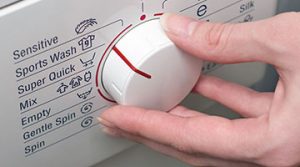Clear instructions on how to wash a duvet

Washing our clothes is an everyday activity. For most households, washing their sheets, pillow slips and duvet covers is also a weekly event. But washing their duvet is a daunting task for many and some people avoid the task because the practical nature of it can be difficult to work around.
Washing a duvet is not a simple one, two, three step task because there are so many anomalies involved in the task. Size and materials and the two determining factors that will influence the temperature, detergent and machine that you will use.
Opinion differs on the frequency that duvets should be washed, however the consensus is that it should be a minimum of once a year and in some cases more often. Some recommendations are once every three months.
Size really does matter
The relationship between the size of your duvet and the drum of your washing machine are particularly relevant. While modern machines are capable of handling between 6 and 8 kilograms of weight, a King size and a Super King size down duvet is most likely going to need a machine with a 10 kilogram capacity, much like the large machines at your local launderette. Once the duvet is in the machine there should still be enough room for the water and the soap to circulate during agitation. If the duvet is simply too large for this then take it to the launderette. Those extra few inches of space will ensure that your duvet comes out clean.
Consider the materials
If the duvet is made up with real duck feathers or goose down, it is advisable to make a prewash inspection to ensure that there are no holes or gaps where the feathers could escape. A few minutes sewing up a small gap or hole will save hours of rescuing both the washing machine and the duvet later. Check that any synthetic materials that either make up the majority of the duvet or have been added as supplementary materials
Temperature
Duvets that contain feathers should not be washed at more than thirty degrees. The rule of thumb is usually around thirty degrees unless the label indicates otherwise. Although a sixty degree was will kill dust mites, don’t forget that duvets can be placed in driers which will reach sufficient heat to perform this purpose anyway.
Synthetic duvets can be washed in temperatures reaching sixty degrees so if you want to dry it naturally you can. If you are trying to dry duvets during cold weather spells remember that as large items they can take a long time to dry and are at risk of developing mouldy patches.
If you are using a domestic machine, you should have no difficulty in controlling the temperatures setting. However, it is likely that if you are washing a large duvet you will be using a machine in a launderette. Ask the assistant how to set the temperature controls and be sure that the machine that you use is appropriate. Larger duvets are more expensive to replace.
Detergent
Although duvets take up much the same amount of space as a load of clothing, you are placing a single item in the machine and so water and detergent distribution will be different. For this reason, an amount equalling approximately a third of the normal quantity of detergent should be sufficient. There should be no necessity for particularly strong detergents unless the duvet is really badly soiled. On the whole a mild detergent at a thirty percent quantity should be sufficient.
Stains
If you are dealing with stain removal, it is important that you pre-treat the stains. A hot wash is likely to fix a stain in the textile and make it nearly impossible to remove. Try to move the filling away from where you are treating the stain so the content inside the duvet don’t have to deal with the treatment too.
Read the label
Some duvets simply are not meant to be washed. Read the label carefully for clear washing instructions. If the label clearly states that the duvet is dry clean only then it would be prudent to take it to the local dry cleaner. A good dry cleaner will know how to get it clean.
The finer details
It is also important to remember that duvets are manufactured differently. If you decide to leave the duvet to dry naturally the distribution of its contents could become compromised by hanging it up. Many duvets need to be dried by spreading them out over a flat surface with a sheet underneath and another on top. Bear in mind that drying a duvet this way can take a long time and in damp climates can lead to mould developing.
Consider the machine too
It is equally important that you take care of your washing machine as you do when washing your duvet. Should you discover that the machine has become overloaded or the wash is too heavy and the machine has stalled, do not try a DIY option. After the usual options to manually drain your machine, it is a good idea to call your local washing machine repair service, to have an engineer sort out the problem quickly and efficiently. In all likelihood this will rescue both your duvet and the washing machine.
By looking after your duvet, keeping it clean and following the care instructions, it will last for years, if not generations.
Get in touch with WM Repair Services
Whatever appliance you have and whatever age it happens to be, you now have easy access to a service you can count on. Our engineers provide repair solutions for all makes and models.
Call 020 3745 7452
Our advice and quotations are free. Whatever it is, just give us a call.
In addition to washing machines, we specialise in repairing a variety of home appliances. Our services include:



